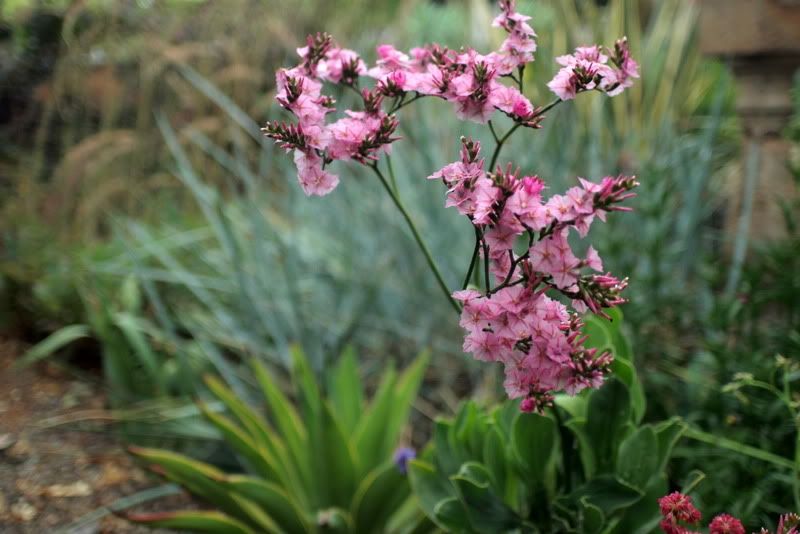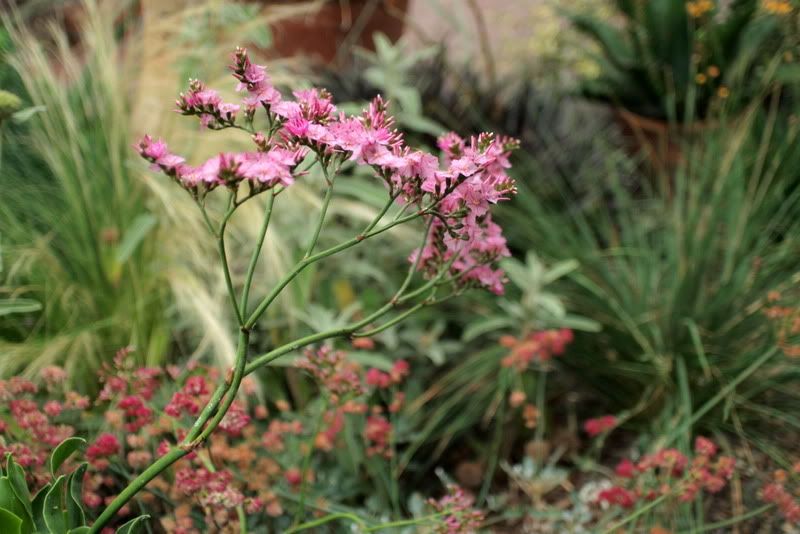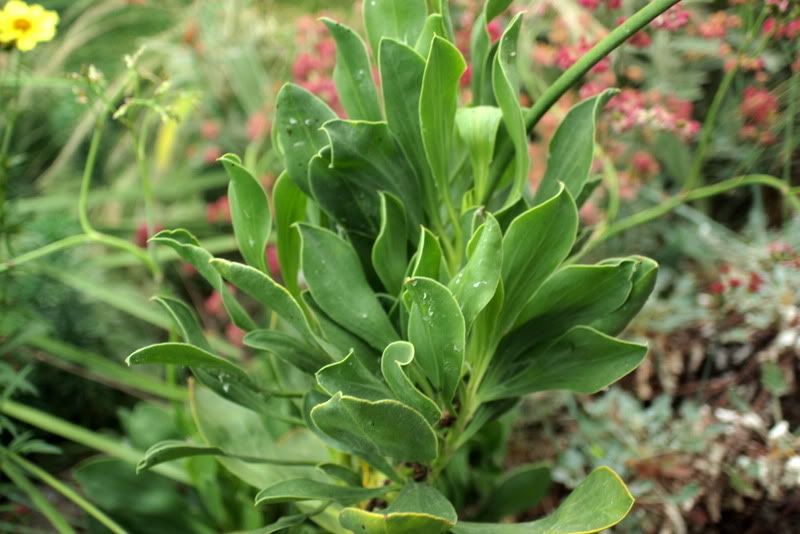The shrubby statice, also goes by Limonium roseum, from South Africa. I just uncovered its true identity this morning using a Google Image search.

The one and only time I’ve seen it offered at a nursery, I bought it, and that was long, long ago. This is the first year it’s flowered. It spent years in the back garden, didn’t do much other than cling to a weak semblance of plant life, then was moved to the front gravel garden, often a death sentence for non-performers. In the sun-baked gravel, watered only by 15 inches of winter rain (in a good year), it not only held on, but increased in size. I always assumed it was a California native, possibly from some dim memory of having grabbed the original gallon from the natives section of a now-closed nursery. Now that I know its name, I find its native soil is sandy. I would never have planted it in the clay of the gravel garden had I known that. A native buckwheat, Eriogonum grande rubescens, at the limonium’s feet enjoys the same growing conditions.

The statice has extremely tough, leathery leaves.

Hortus Third has this to say: “Shrub, to 3 ft., brs. leafy, covered below by persistent lf. bases; lvs. obovate, to 3 in. long, tapering to a clasping base, scabrous on 1 or both surfaces with pitted glands; fl. scapes scabrous infl. dichotomously branched, spikelets 1-fld., few to many, close-set in spikes; calyx to 1/2 in. long, funnelform, limb 5-ribbed, pink, corolla pink, longer than calyx. S. Afr.”
Say what?
Lambley Nursery & Gardens in the UK has this to say:
“One of the finest dwarf shrubs for a dry climate. This statice, to quote E.E. Lord, ‘….. will endure dry conditions and inland frosts alike.’ Limonium peregrinum forms a low rounded evergreen shrub with leathery bright leaves. For much of the year it has flat topped sprays of bright rose pink flowers held well above the leaves. These are good cut flowers and a delightful addition to posies. Difficult plant to propagate.”
And I’d add extremely slow to grow. It’s taken it close to a decade to produce flowers for me. It’s also apparently notoriously difficult to start from seed. No idea who E.E. Lord is, quoted above, and a quick search was fruitless.
So what’s to be learned from this botanical mishegoss?
a) If you neglect a plant long enough, it may surprise you and not die;
b) If you don’t grab that unfamiliar plant at the nursery, you may never see it offered again.
c) Sometimes having no information at all on a plant works out OK.
d) The dumb occasionally get lucky.
I’m going with (b).

Cool plant. Another lesson I keep learning from plants that are struggling – it really pays to move them into different conditions if they’re just limping along.
Isn’t it an incredibly lucky feeling, when you buy something not knowing what it is, and it turns out you stumbled on a rare find? Makes me feel very clever when that happens.
Wow Denise, thats a beauty..and what a character building event your long wait for the appearance of not only the bloom, but some signs of health..the failure to buy the plant : reverse buyers remorse. This also occurs in antique stores. I try to avoid it at all costs.
Megan, this statice being somewhat rare makes me feel nervous!
Kathy, with the gravel garden nearly filled to capacity, these little experiments will have to stop — unless I follow your lead and start removing cement.
Lambley Nursery is actually in Australia, although the owner is originally English. It is a very good nursery there for dry climate plants.
I live in South Australia and when I visit the Fleurieu Peninsula coastal areas of my state I see this plant growing wild everywhere and flowering prolifically in summer. It evidently likes the sandy soil and the mild maritime climate. Next time I go down there I’ll try to grab some seed and have a go at propagating it. I have one plant now but it is sulking as it is in clay soil. Our Adelaide summers are awful here with 110 degree heat and can be hard on even tough plants like this one too.
I am Spanish grower and I am very interested in growing limonium peregrinum but I can´t find seeds or plants. Do you know who could provide me with them?
I am from Adelaide, South Australia and I have a limonium Peregrinum in my garden. I know you can buy them online from The Diggers Club (www.diggers.com.au) and also Lambley (www.lambley.com.au) but they seem very hard to come by in nurseries. I live near the beach and mine is planted in a full sun position in sandy soil. It cops a lot of wind and survives in our terribly hot summers with no care. I never water it, even in summer, and it still thrives. I’ve had it for about 5 years and it’s huge now! I’m actually trying to find info on how to prune or divide it. Any thoughts?
To the Spanish grower who is looking for Limonium peregrinum plants, you could try
Pépinière Filippi who are in Mèze, near Béziers: http://www.jardin-sec.com/
Sarah, my limonium withered away, and I never was able to get cuttings to root before its demise. Yours must be an amazing sight.
See source provided by Liz. I know of no sources at this time.
Thanks so much, Liz!
Thanks for this! I’ve had this little plant hang on and even flower for four years but it is growing about a centimetre a year so I was wondering whether it would like a move. I was a Lambley recently and saw it there – before I had no idea what it was! I’m glad to hear it can be moved – I have just the right sandy, uncared for conditions just waiting for a new plant 😉
I have a low border of Limonium peregrinum syn.roseum facing north which is a full sun position with heat to 40 0 C in summer.
I purchased these from David Glenn at Lambley Nursery at Ascot Victoria. The website is http://www.lambley.com.au and I can vouch for the quality stock and packing from Lambley.
As my soil is heavy clay I had to modify this with lots of sand and raised the soil level. We also have winter spring frosts to -4 degrees C which does not affect or check the growth. The plants have bushed up well over about three years, and flower sprays are lovely in a vase for summer or dried for winter display. My only problem seems to be a native wallaby which eats young new growth!
Lynne, even though I’m in the U.S. I check the Lambley website often! What an amazing nursery and garden. Thanks for your notes on culture for this statice. I no longer grow it and haven’t seen it again in nurseries. At least now we know native wallabies love it! I did bring home the German statice, L. latifolium this summer. Thanks so much for your comment.
please can anyone tell me if this plant smells when it gets wet mine. I have a smell like something has died but it only happens when it rains and im sure its this plant. mine is about a metre high and about a metre and half wide.
Unfortunately Vanessa, no perfume or “smell” associated with the plant